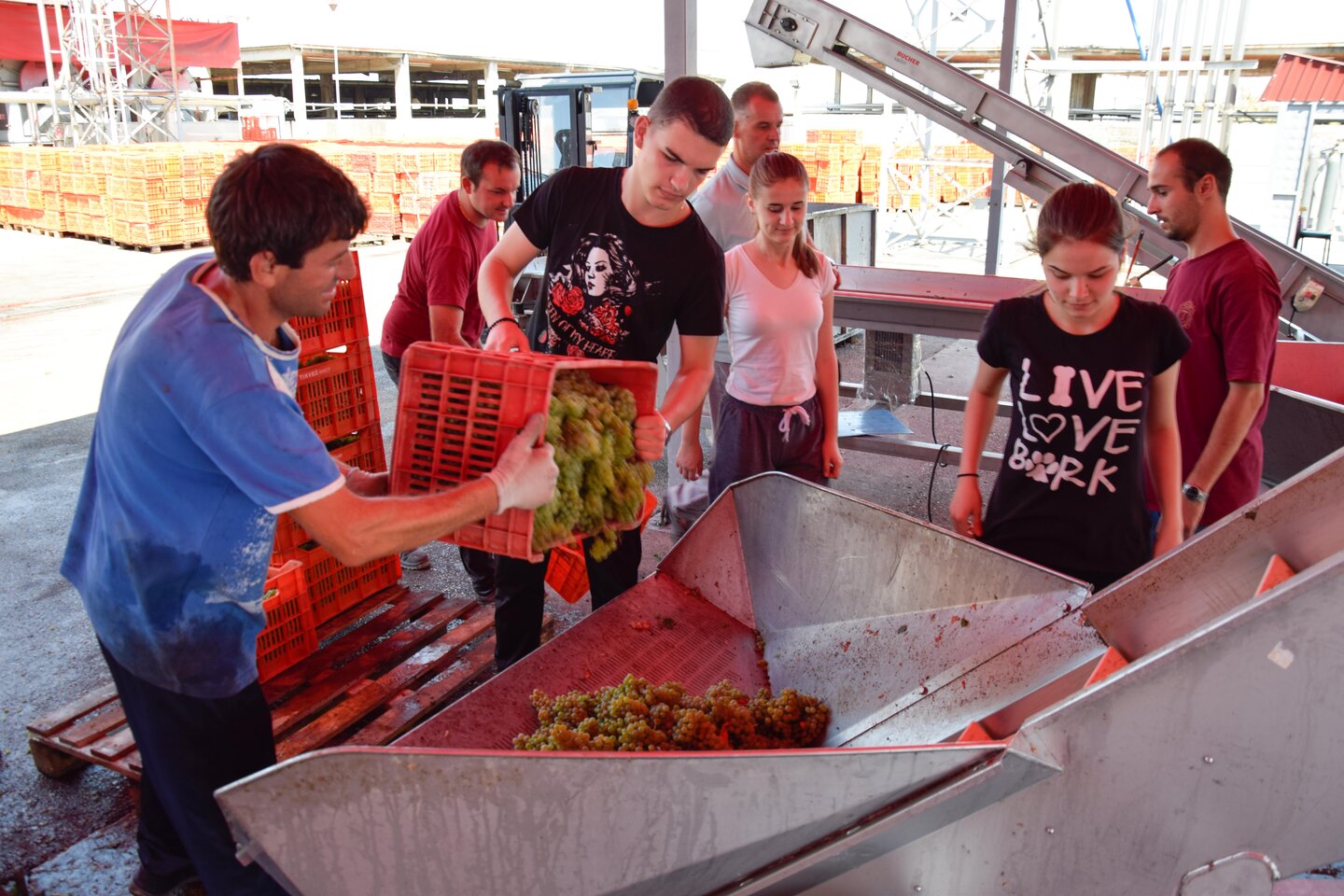“Who is profiting from school?” asks the offscreen voice in a video recently published by Helvetas on the benefits of enrolling for vocational education. “Is it Ari, who chose to become a systems technician? Is it Era, who went for a career in the construction sector? Or is it Nora, who spent 12 years studying law at university, only to end up settling disputes among her siblings at their parents’ kitchen table?” These provocative questions are part of a media campaign that aims to change the perception of vocational education and supports smart career choices.
As discussed in the June issue of Mosaic, labor markets are constantly evolving. Can the education sector keep up and provide the required labor force supply? Should vocational careers be favoured over academic ones? What is the role of international development in all of this?
Predicting the future
Even if one has all the statistical data at hand, is familiar with the global educational trends, and can forecast the future economy needs, many questions remain unanswered. One of the hardest decisions primary school students and their parents face today is regarding secondary education. This decision is even more difficult due to the lack of career information and guidance services in many countries of Southeast Europe.
Primary students usually have the choice between enrolling at a gymnasium or at a vocational education and training (VET) school. The gymnasium is preferred by better performing students. Those who enrol in vocational schools, mostly do so as it represents a backdoor to university. It is a less-favored option. This story applies to North Macedonia, and to most of the Western Balkans region.
According to the State Statistical Office of North Macedonia, in the academic year 2017/2018, approximately 27,000 students enrolled in gymnasiums while 42,000 students joined vocational school, presenting a ratio of about 1:1.55 in favor of the vocational schools. These numbers read quite well on paper as most of the students will become part of a skilled workforce serving the demand from employers, while the rest will pursue a university degree to become economists, lawyers or ultimately managers. And the economy will flourish. Well, not necessarily.
Let’s look at the 27,000 gymnasium students: For decades, the North Macedonian state and society have been inclined to steer the youth towards a university degree. This strategy caters well for the aspirations of thousands of parents hoping for their children to become part of the academic world, dressed up in a suit and tie. And it could be a fairy-tale story if one avoids asking the ultimate question: What particular skills do the students acquire in a gymnasium and what happens to those who don’t get into university?
North Macedonia is not the only country in the region focusing its funds mainly on the academic track. The same happened in Kosovo in 2007, when the threshold to enter university was lowered and a previously mandatory bridge year was made obsolete. At first glance, this might seem like a good and fair idea since it allows every young person the highest possible level of education. However, no economy can thrive on academics alone, and rapid expansion usually lowers the overall quality of the programs. But there was a hidden agenda: Kosovo faced (and still faces) quite a high level of unemployment. The cause continues to fall back on the people in charge. By enrolling masses of youth in universities, the numbers disappear from the unemployment statistics. Less of the youth is seen roaming the streets, potentially creating trouble. But mitigating social problems by misusing the education system isn’t a long-term solution.
Let’s now look at the 42,000 students in vocational schools in North Macedonia. In about 2 to 3 years, North Macedonia will have a generation ready to partially fill the gap in the skilled workforce, right? Well, not exactly. A fair part of the VET schools in North Macedonia and the Western Balkans have a poor reputation. Some use outdated curricula, most offer limited practical training opportunities and have limited communication with the private sector to foster closer cooperation.
Towards demand-driven and practical education
To be fair, there are bright examples of vocational schools in the country and the region, too. However, these are rare. While most primary students enrol in vocational schools because of lower grades or already full gymnasiums, a certain number join in order to acquire the knowledge and skills for a professional career. But do the students really get what they need at work? Unfortunately, not.

Practical skills – that’s something which both, gynasium and vocational training students, are not getting enough of. The governments of the countries within the region are aware of this. In 2015, ministers from all EU members and membership candidates, including most Western Balkan countries, came together in Riga to confirm that VET should be pushed both in terms of quality and status. They univocally agreed that one specific element of VET should have priority, namely work-based learning (WBL), which includes apprenticeships, traineeships, internships and on-the-job training in companies. Through exposure to real-life working situations, the students can learn to implement the theoretical knowledge acquired in the classroom. This could compensate for the missing skills.
But why is WBL so rare in the region’s education systems? High quality national VET strategies, usually developed with the support of international experts, are in place in all the countries in the Western Balkans - but the necessary by-laws are missing. These laws are crucial as they define roles and responsibilities regarding the financing of WBL and processes defining occupational standards - the backbone of every vocational profession. The political motivation is weak to push these by-laws forward as they allow holding ministries accountable.
The educational system in North Macedonia is currently generating large numbers of under-skilled economists, lawyers, ICT engineers, electricians, chefs, machine operators, etc. that have never been, or are rarely exposed to a realistic scenario where they can exercise their future profession. While they struggle to find quality jobs, the employers face large up-skilling investments to turn them into efficient employees. Businesses are usually not willing to pay for this and that’s where the blame game between the private and public sector begins. The result: significant youth unemployment on the one side, and overqualified young people working in sectors unrelated to their studied topic on the other. The growing frustration fuels economic migration.
“You know why the best coffee in the world is served in the Western Balkans? Because it's prepared by people with a PhD!” (A common joke in the region)

Making a positive start
The issues described above bring us back to the initial questions of the future of education in North Macedonia and the Western Balkans, and how we, as development practitioners and organizations, can support local efforts. While there is no quick fix solution, there are many areas of intervention:
- Technology and services change very fast. The educational system can only keep up with this pace through partnerships with the private sector. Encouragement and support to the private sector to systemically cooperate with vocational schools and adapt curricula based on the actual needs of the labor market is called for. This is being done within the scope of the ongoing EYE (Enhancing Youth Employment) project in Kosovo.
- Develop new models for WBL and help the partners to pilot them by buying down the risks. The best models might not be the ones that the development practitioners envision initially. Hence, they need to be flexible and adaptive; and listen carefully to the needs of the local partners. Avoid paying for the apprentices or trainees directly, as this creates donor dependence. Instead, try to convince the companies themselves to invest in their future employees. Both EYE in Kosovo and the Moja Budućnost project in Bosnia and Herzegovina, seek solutions to address the challenges of youth unemployment.
- Initiate a change of perception towards vocational education. Point out the obvious: currently, vocational occupations (especially ICT-related) are in high demand and are well paying. This will probably remain so for the next 10-15 years. This has been done by the medial intervention by Risi Albania. Support disruptive and provocative campaigns to challenge old habits, generation conflicts, like those between parents and children, and gender stereotypes. Obviously, this should happen with the necessary caution so as to not offend anybody.
- Work closely with high growth potential economic sectors and help them find individual industry solutions, if the public sector is not willing or able to act. The non-formal education sector might have solutions to fill the skills gap where the formal sector has none. The whole vocational education sector needs a sprinkle of market orientation. Look out for local champions, VET schools and companies that are willing to push new ideas forward and take risks.
- Support and motivate responsible governmental bodies to implement useful and smart by-laws that define roles and responsibilities in the VET system. Avoid overlapping or contradictory laws as they lead to infamous blaming. Avoid creating more dependence on the procedures and processes from international donors as this creates a bubble which will burst as soon as projects end and funds run out. Unfortunately, this is happening in many countries of the region. Think about long-term solutions.
- Use successful VET role models from Switzerland and Germany as inspiration and facilitate knowledge exchange. But avoid copy-pasting their elements into the very different circumstances in the Western Balkans. What works in these established economies doesn’t necessarily work in an emerging country. Be flexible and listen carefully to the needs of local partners. Based on the Swiss dual education system, there are education models being piloted in a number of countries within the region.
- Strengthen the role of meso-level organizations such as sector associations, chambers of commerce, trade unions, sector and regional councils. Their potential is not fully exploited, and they play a crucial role in a functioning and more market-oriented education system.
Read more on the Future of Education in Southeast Europe.
Subscribe to Helvetas Mosaic
Helvetas Mosaic is a quarterly published by Helvetas Eastern European team for our email subscribers and website visitors. Our articles explore new trends and fresh ideas of international development work in Southeast Europe.

